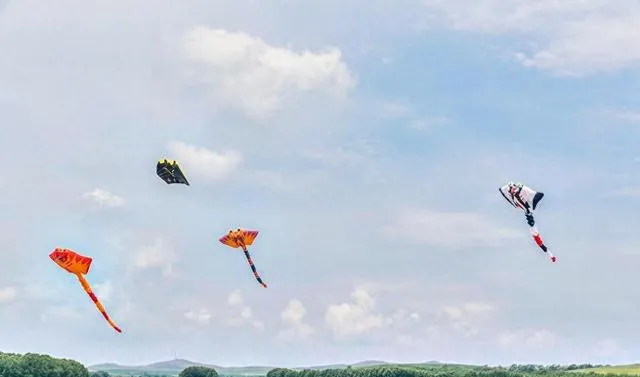Kites: Soaring Symbols of Chinese Wisdom and Artistry

Kites have been a part of human history for over two millennia, with their roots firmly planted in the fertile ground of ancient Chinese innovation. The story of the kite begins with the legendary philosopher Mo-tse, who is said to have crafted the first "Zhiyuan" for strategic military use. These early kites were not just toys; they were vital communication tools and wind indicators, playing a crucial role in the tactical landscape of ancient warfare.
风筝作为人类历史的一部分已有两千多年的历史,其根源深植于古代中国创新的肥沃土地上。风筝的故事始于传说中的哲学家墨子,据说他为战略军事用途制作了第一个「纸鸢」。这些早期的风筝不仅仅是玩具;它们是重要的通信工具和风向标,在古代战争的战术格局中扮演了关键角色。

The transformation of kites from military signals to a form of public entertainment was catalyzed by the introduction of paper kites. This innovation opened the skies to the masses, allowing kite flying to become a universal delight that transcended borders, eventually finding its way to Europe and beyond. The kite's influence on human aspiration was so profound that it is believed to have sparked the idea of human flight, paving the way for the airplane's eventual invention.
从军事信号到公共娱乐形式的转变是由纸风筝的引入所催化的。这一创新为大众开放了天空,使放风筝成为一种普遍的乐趣,超越了国界,最终传播到欧洲和更远的地方。风筝对人类抱负的影响是如此深远,以至于人们相信它激发了人类飞行的想法,为飞机的最终发明铺平了道路。

The craft of kite making is a revered tradition in China, where it has been meticulously refined over the ages. The process involves the careful construction of a framework using slender bamboo strips, followed by the application of paper or silk to create the kite's body. The kites from Tianjin, Beijing, and Weifang are especially celebrated for their exquisite craftsmanship, vibrant designs, and exceptional aerodynamics, which distinguish them as masterpieces of kite artistry.
风筝制作在中国是一项受人尊敬的传统,历经数个世纪的精心提炼。这个过程涉及使用细长的竹条仔细构建框架,然后应用纸张或丝绸来制作风筝的身体。天津、北京和潍坊的风筝尤其因其精湛的工艺、生动的设计和卓越的空气动力学而受到赞誉,它们被视为风筝艺术的杰作。

In recent times, the world of kites has seen a creative rebirth with the emergence of new patterns featuring painted characters. This modern evolution adds a fresh dimension to the kite's cultural significance, blending traditional artistry with contemporary flair. Yet, the traditional kites, with their intricate depictions of animals, insects, and aquatic life, continue to captivate the imagination, embodying a timeless bond with nature and the rich heritage of Chinese mythology.
近年来,随着新图案的出现,风筝世界经历了一次创造性的重生,这些图案上绘有字符。这种现代演变为风筝的文化意义增添了新的维度,将传统工艺与现代风格融合。然而,传统的风筝,以其复杂的动物、昆虫和水生生物的描绘,继续吸引着人们的想象力,体现了与自然和中国神话丰富遗产的永恒联系。

The kite's evolution—from a military device to a cultural icon and a cherished childhood pastime—reflects the dynamic progression of human society and our insatiable desire to explore and understand the world around us. As the kite soars on the currents of change, it stands as an enduring emblem of human creativity, a bridge linking the past with the future, and an inspiring reminder of the boundless possibilities that can arise from the simple, yet profound act of setting our dreams aloft.
风筝的演变——从军事装置到文化象征,再到珍贵的童年娱乐——反映了人类社会的动态进步和我们对探索和理解周围世界的不懈渴望。随着风筝在变革的潮流中翱翔,它成为了人类创造力的持久象征,一座连接过去与未来的桥梁,以及一个鼓舞人心的提醒:简单的、然而深刻的放飞梦想的行为中可以产生无限的可能。











